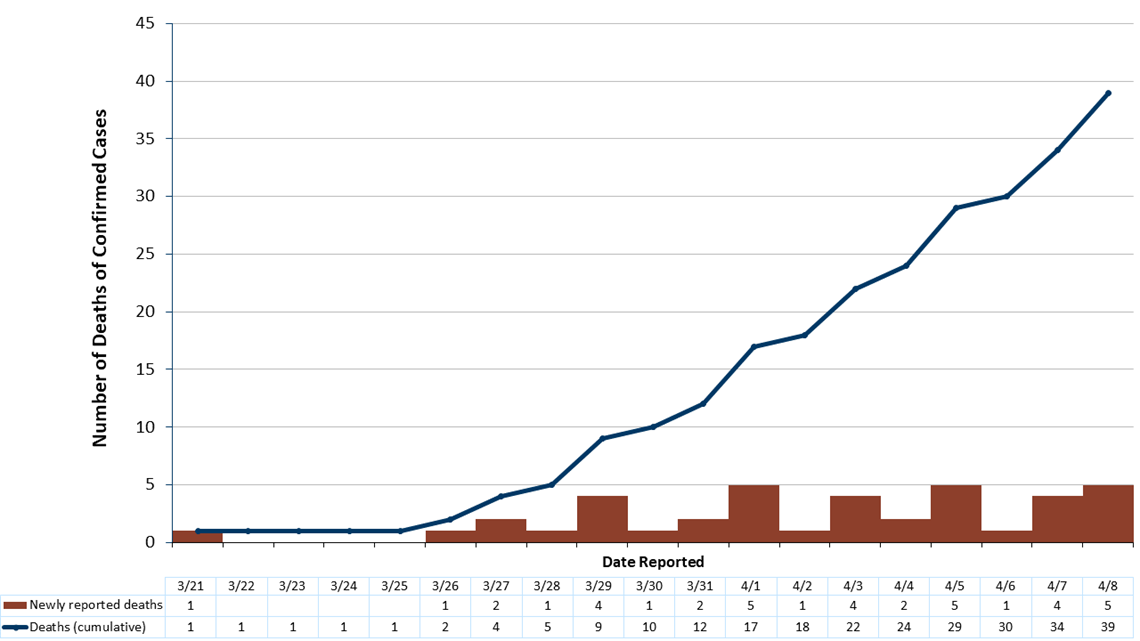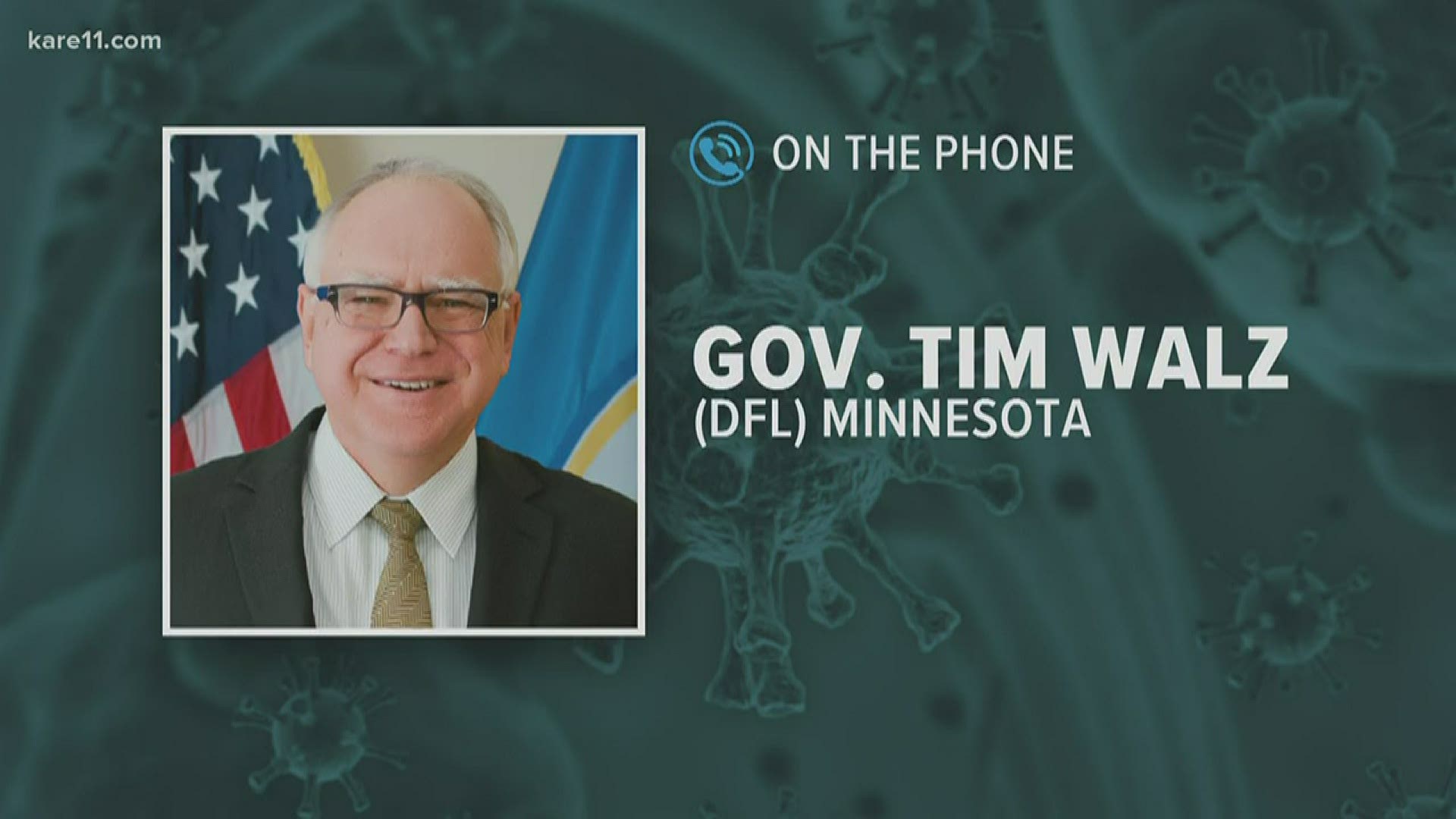Monday, April 13
3 p.m.
Minnesota will not open for business until there is more widespread COVID-19 testing, Gov. Tim Walz said on his regular update call with state officials Monday.
The governor said he is "totally supportive" of allowing Minnesota restaurants to sell alcohol along with their takeout food. He said he hopes the state legislature will move that measure Tuesday, and he can sign it the same day.
"We're trying to do everything we can to keep these businesses afloat," Walz said, reiterating that with the recent extension of the "Stay at Home" order his administration is working with businesses to figure out how to get people back to work if it can be done while allowing for social distancing.
When asked about a timetable for a more large-scale reopening of the economy, though, Walz said "the virus will lay out the timetable for us."
"There’s not a debate here about whether we need to get the economy open again, of course we do," Walz said.
He referenced the Smithfield pork plant in Sioux Falls, which temporarily closed down with 300 workers testing positive for COVID-19. If businesses reopen and allow people to go back to work without measures in place to mitigate the virus' spread, "the economy shuts down anyway," Walz said.
Walz maintained that he believes the only way to reopen the economy is to be able to more widely test and find out who currently has the virus, and who has already had it and has built up some immunity. Then those who are vulnerable or sick can remain isolated, while others go back to work.
"I’ve said from the beginning, we cannot shelter in place or stay at home until we get a vaccine," Walz said. "That’s not sustainable. We knew that."
About 40,000 people in Minnesota have been tested for coronavirus so far since late January, among a global shortage of test kits, swabs, reagent and personal protective equipment needed to administer the tests.
Walz said he believes we will need to be testing 40,000 Minnesotans per week in order to more fully reopen the economy - or about 5,000 per day.
Citing a lack of federal supply of testing equipment to states, Walz said his administration is working to increase testing capacity within the state, independently and in collaboration with neighboring states.
"We’re going to attempt to ramp up our testing fairly significantly in the short term," he said. When asked if it would be ready by May 4, the date the "Stay at Home" order is scheduled to be lifted, Walz said, "We'll find that out."
He acknowledged that ramping up testing, with the limited supplies, will be a "hard lift."
"Those that keep asking, 'What’s the plan to reopen?'" Walz said. "The plan to reopen is very, very clear. Test, trace, isolate, open back up. And continue this until we get a vaccine."
During the Monday update, Minnesota Management and Budget Commissioner Myron Frans said that he is working with the governor on releasing an updated budget projection in early May, so they can gain a better understanding of COVID-19's effect on the state's finances.
They are placing a hiring freeze on all executive branch positions that are not related to coronavirus response. In addition, Gov. Walz, his chief of staff, and all 24 cabinet commissioners will be taking a 10% pay cut for the remainder of the year.
Metropolitan Council Chair Charlie Zelle also announced that starting Monday, Metro Mobility will provide free door-to-door transit to any health care worker who needs a ride to or from work. That service is available 24/7. Health care workers can sign up online or by phone, and will need to provide their employee identification to Metro Transit.
Zelle said they are able to do this because of the drop in demand for other services. Metro Transit has also been delivering groceries and food from food shelves, Zelle said.
Noon
Minnesota Gov. Tim Walz has extended the state's "Peacetime Emergency" declaration for an additional 30 days.
Walz originally declared a peacetime emergency on March 13, as his administration geared up to fight the spread of COVID-19 and shore up health care resources. Under the declaration, the governor has issued several emergency orders, including the "Stay at Home" order recently extended until May 4.
The emergency declaration also allowed Walz to activate the Minnesota National Guard for help in preparations and delivery of medical supplies.
“Our actions have saved lives, but the threat of COVID-19 remains,” Walz said in a statement on Monday. “The next stages of this pandemic are going to challenge us – an extension of Minnesota’s peacetime emergency will allow us to protect Minnesotans’ health and wellbeing and continue to respond effectively to this rapidly-evolving situation.”
The state's emergency declaration is now extended through May 13.
Last week, Minnesota's request for a federal disaster declaration was also granted, freeing up certain federal funding for COVID-19 relief.
11 a.m.
The Minnesota Department of Health says 1,650 people have now tested positive for COVID-19 in the state, and 70 have died.
A total of 842 people who tested positive no longer need to be isolated.
There were no new deaths reported Monday and only 29 new cases. Normally MDH reports Sunday's numbers on Monday. This week, they reported some of those updates on Sunday, which made Monday's increase unusually low.
One hundred and fifty-seven people are hospitalized as of Monday, and 74 of those patients are in the ICU. In total, 361 people have been hospitalized since the outbreak started.
The median age of people testing positive is 52, and the median age of both hospitalized and ICU cases is 65. Of people who have died, the median age is 88.
At this point, MDH believes 25% of COVID-19 patients were exposed through travel, and 20% are in congregate care settings. MDH is prioritizing testing for those in congregate care, as well as hospitalized patients and health care workers.
Hennepin County has seen the most cases of coronavirus at 557. Ramsey has 152 and Olmsted has 143.
Sunday, April 12
2 p.m.
The Wisconsin Department of Health released its latest COVID-19 figures for the state on Sunday.
Wisconsin now has 3,341 confirmed positive cases up from 3,213 on Saturday. Deaths have risen to 144, up from Saturday's 137.
Of those deaths, 88 have occurred in Milwaukee County.
Wisconsin health officials say a total of 974 people have been hospitalized with complications from the coronavirus since the start of the pandemic, 29% of those who have tested positive.
Of those testing positive for the coronavirus, 20% are between the ages of 50 and 59; 18% are 60 to 69; and 16% are from 40 to age 49.
Fifty-three percent of those testing positive are female as compared to 47% male, but men make up a larger percent of the state fatalities at 60%.
Milwaukee County has the most cases at 1,710, while Dane, Waukesha and Kenosha Counties report 334, 209 and 173 positive cases respectively.
11 a.m.
The Minnesota Department of Health (MDH) has identified 194 new coronavirus cases in the state. MDH announced another six deaths, which brings the statewide total to 70. The total number of cases is 1,621 as of April 12, which is up from 1,427 on Saturday. In a press release earlier this morning, MDH reported 1,536 total cases but additional cases, which would have typically been reflected in Monday's report, were included.
MDH says 361 of those cases in total have required hospitalization, and 157 are still hospitalized while 74 are in intensive care. There are 842 patients of the total who no longer need to be isolated.
Approximately 9,385 of tests have been done by the MDH Public Health Lab. And approximately 28,036 have been done by external laboratories.
Hennepin County has the most cases at 557. Ramsey County has reported 152 cases, followed by Olmsted County with 143 cases.
Friday, April 10
6 p.m.
Governor Tim Walz has issued Emergency Executive Order 20-32, which authorizes the limited sharing of public health information from the Commissioner of Public Health to first responders and the Department of Public Safety.
According to a release from the State of Minnesota's Executive Department, emergency personnel will be supplied with addresses containing individuals who have tested positive for COVID-19 and are still contagious.
The release says no identifying information will be shared beyond a person's address, and addresses can only be shared with the Department of Public Safety (DPS), 911 dispatchers and first responders.
Governor Walz believes this will enable these emergency workers to properly socially distance themselves, and preserve their own health, while preventing the spread of COVID-19.
The release states that only the addresses of individuals the Minnesota Department of Health (MDH) had detected to have COVID-19 will be shared.
MDH is required by this order to notify DPS when it believes addresses no longer contain contagious individuals, at which point DPS is required to delete the information from their database.
Emergency workers and public safety workers who receive the shared health information can only use that information to the extent it protects their own health and the health of their fellow workers.
The order remains in effect until Walz's former peacetime emergency declaration (issued as Executive Order 20-01) is "terminated or rescinded by proper authority."


KARE 11’s coverage of the coronavirus is rooted in Facts, not Fear. Visit kare11.com/coronavirus for comprehensive coverage, find out what you need to know about the Midwest specifically, learn more about the symptoms, and see what companies in Minnesota are hiring. Have a question? Text it to us at 763-797-7215. And get the latest coronavirus updates sent right to your inbox every morning. Subscribe to the KARE 11 Sunrise newsletter here. Help local families in need: www.kare11.com/give11.
The state of Minnesota has set up a hotline for general questions about coronavirus at 651-201-3920 or 1-800-657-3903, available 7 a.m. to 7 p.m. There is also a data portal online at mn.gov/covid19.
More information on the coronavirus:


